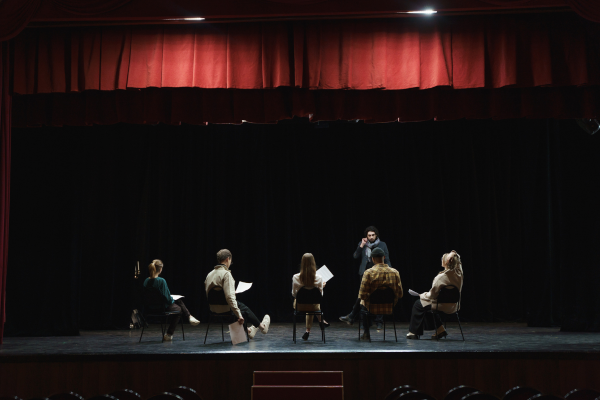10 April 2025
How Theatre Promotes Mindfulness in the Classroom
Elise Czyzowska
Senior Content Marketing Executive
Theatre encourages us to live in the present. Whether we are watching, discussing, or even performing a play or musical, it asks us to engage with what is happening and to pay attention to every detail...
In this way, theatre can be seen as a mindfulness activity that supports students as they navigate the daily challenges of growing up, and teachers as they seek to inspire and engage their class.
Here are four ways theatre can promote mindfulness in your next lesson – including hands-on activities and resource suggestions!
Theatre teaches Emotional Regulation
Theatre has a unique ability to help individuals find their voice. Playing roles or creating theatrical scenes provides a safe space to express emotions that might otherwise be suppressed – and for students experiencing new and intense emotions, theatre provides a constructive outlet.
For teachers, this can have an enormously positive impact, reducing behavioural problems and even increasing regular school attendance by giving students healthy alternatives to simply ‘avoiding’ problems in their lives.
Instead, through characters and stories, they can channel these complex feelings into meaningful expression, learning healthy coping mechanisms and building resilience against stressful situations in the future.
Try it in the classroom!
- In groups of three, assign two students the role of 'actors' and one student the role of 'conductor' and give each group a topic (choose a vague topic with lots of points for discussion, such as the weather or social media).
- When the conductor points to one actor, they should start to rant about that topic and continue until the conductor points to their partner (at which point the second actor starts their rant).
- Each time the conductor points back to an actor, they should try to increase their emotions, becoming more and more passionate about the points they are making, helping them to learn how to channel their emotions into theatrical performances.
Find this practical exercise - and many more - in this e-learning video, How to Use Emotions!
Theatre Encourages Goal-Setting
Often, theatre inspires discussions about how hard people work to achieve their goals – whether it’s in the story being told, as with the Younger family in Lorraine Hansberry’s A Raisin in the Sun, or in off-stage cast interviews with cinematographers and set designers, opening a new world of possibilities for students.
“By showing students the end goal, it gives them something to aspire to. It increases longevity in our theatre programs – more kids are getting involved in technical theatre courses, but it also shows them that a career in the arts is a viable option, especially for our High School students.”
– Joseph, Fine and Performing Arts Resource Specialist, US
This point about program longevity also supports teacher mindfulness by reducing the need to ‘prove’ results. When it comes to budget and resource cuts, the ability to qualify ‘value’ through attendance, outcomes, and student engagement is invaluable.
Try it in the classroom!
- Put students in small groups of three to five, and tell them they are now a production team.
- As a team, students should choose a fairy tale that their imaginary company will be producing and then create a list of goals for the production to accomplish.
- Explain to the class that their goals should come from what their production will focus on – for example, if they have chosen to create a musical of Little Red Riding Hood, then they need to focus on allowing time for music and choreography rehearsals.
- Ask each group to create a list of their production goals, ordered from highest to lowest priority.
- Stretch: Have groups share their lists and discuss why their goals and priorities might be different.
This activity is from our Creating Goals for a Production lesson plan.
You might also enjoy ‘Being an Optimistic Performer’, a visualization
exercise led by Broadway performer Syndee Winters!
Theatre Develops 21st Century Life Skills
Just as e-learning videos help to increase engagement across multiple disciplines, theatre has cross-curricular benefits in developing 21st Century life skills:
- Critical Thinking: Key scenes and performances help students to consider the words on the page against authorial intent, as well as the different interpretations of creatives involved in each unique production.
- Creativity: The process of watching, responding to, and creating new theatre leads to a cycle of inspiration, reflection, and creativity that is found in many future career paths!
- Collaboration: Putting on a play is inherently collaborative, whether it’s a small ensemble piece or the entire class working together on a school production.
- Communication: Theatre supports the development of presentation and listening skills, developed through group work, peer feedback, and rehearsal sessions.
“Digital Theatre+ has helped give my students the tools to truly listen, understand, and analyze. They have been informed and inspired by the voices of others, and now they have the courage to share their voices. Digital Theatre+ has proven that theatre is not exclusive – theatre is for everyone.”
– Jason, Head of Drama, UK
Try it in the classroom!
- Print out copies of a speech from the play you are studying and hand these out to your class.
- Ask students to read the speech and write down their initial reaction on a post-it note, which the class can discuss until you feel they are confident with the meaning of the script.
- Put students in pairs and assign students A or B, where A is the 'performer' and B is the 'listener'.
- Using a small excerpt, A should deliver this speech to B, who will act as the 'world's worst listener' – in order to get B's attention, A should experiment with new performance tactics, such as gestures, eye contact, and the speed or volume at which they speak.
- This exercise should develop the students' confidence and communication skills, while helping the class to experience the text they are studying as 'active'.
Find this activity in the Shakespeare in your Space workshop!
Respark YOUR Passion for Theatre
As many theatre teachers have told us, the greatest challenge of teaching theatre is trying to ‘explain’ the value of art or a particular movement or style. Incorporating full-length productions or key scene excerpts into the learning process creates an experience for students that increases engagement and accessibility.
Student well-being has been shown to influence teacher satisfaction, reduce teacher burnout levels, and create a more meaningful learning environment overall.
“Digital Theatre+ renews my love for the theatre. It keeps me wanting to see more theatre, and to do more theatre. I’m a passionate teacher, and this platform makes me excited to take all of my love for theatre and bring it into the classroom!”
– Daniel, Theater Lecturer, Canada
Already a customer? Dive into the benefits of theatre with this e-learning video!
Related blogs
5 Top Tips to Encourage Reluctant Readers
It’s no secret: reading isn’t every student’s forte. For some, it’s seen as a boring, old-fashioned...
Read moreThe Stanislavski Method: Practical Exercises for High Schoolers
Born in 1863, Konstantin Stanislavski was a Russian actor, director, and theorist.
Read more8 educators to follow on social media (and 10 hashtags to check out)
It may be that you’re already a social media pro, fully equipped with accounts specifically...
Read moreGet the latest teaching tips straight to your inbox
Explore free lesson ideas and inspiration, education news, teaching trends and much more by signing up to regular blog updates!








